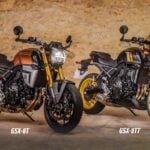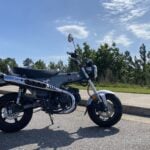How many motorcycles are really enough?
I’m a lifelong motorcyclist who is soon going to be 66 years old! As they say—time flies and it’s hard for me to believe. I started riding at age 12, and I think I had owned about 20 bikes before I got my driver’s license at 16 in 1974. Once I got my license, I always owned two or three cars and two or three bikes at the same time. I also owned a small bike shop in the late 1970s. I guess I had easily owned more than a hundred motorcycles by the time I completed graduate school. But I didn’t have a personal fleet of bikes at the same time until 15 or so years later.
By 1996, I was doing pretty well. I had already owned my own “real” business for eight years—a management consulting, research, training, and publishing firm serving the architecture and engineering industry, based in the Boston area. We were very successful, and got on the Inc 500 list of fastest-growing privately-held companies two years in a row, in 1995 and ‘96.
More space, more bikes. Let the collecting begin. 1975 Yamaha RD250, among the growing “fleet”.
Things in our business just kept getting better and better, while at the same time certain aspects of life at home were slowly getting worse and worse, as my first wife began a long slide into addiction and mental illness that would come to a head years later. We had just moved into a new house in Sherborn, Massachusetts, with a two car garage and a largely finished 2500 sq foot basement with a side entrance that was only down a few steps. Our prior house was old and small, and only had a small shed for the cool stuff we owned, like bicycles and lawn mowers. The new place was the perfect time for me to really feed my motorcycle addiction!
The 1967-ish Benelli/Motobi 125/200/250/whatever it was.
At the time we moved into that house, I only had one bike- a 1984 Honda Ascot VT500 that I had bought slightly used and kept for nearly 20 years. When I bought it, I didn’t realize that someone, in an effort to lower the seat height, had put a 16” rear wheel on it from a VT500 Shadow instead of the 18” that it came with from the factory. I didn’t know much about “new bikes” (which is what I considered it) at the time. It also had crash bars and a windshield, and the Honda Shadow’s exhaust system. Of course the first thing I did when I got it home was pull the windshield, crash bars, and exhaust, and threw them away. I then replaced the bulky Shadow exhaust system with a cheap Mac two-into-one header. I also eventually got an 18” rear wheel for it and had the seat built up to make it more comfortable to ride. But that little Honda wasn’t enough for me when I had the space that my then-new house had, to work on and store bikes.
The Sears/Gilera 106SS I always loved.
We started out by redoing the basement and creating what was about a 1000 sq foot beadboard-paneled bar/motorcycle room. We built a great bar with a glass top to display memorabilia from my youth, like old bike brochures, bills of sale and such, and I even built out a cigar smoking area with a vent hood that took it right out of the house. I also put together a separate workshop/restoration area and shelved room for parts and projects. Believe me, other than a short, steep ramp to get bikes in from outside, it was a super setup.
So the amassing of motorbikes started pretty quickly. First thing I did was buy a perfect, original, 600-mile Sears/Gilera 106SS I found in response to an ad I had placed in Walneck’s Cycle Trader. I had owned one as a kid that I bought for $5 and was always fascinated with them!
Anna on the little PW50 we bought her. She was happier than she looked.
Then I picked up a like-new Honda CL70 that I taught my oldest daughter to ride on, as well as a new PW50 for my youngest daughter and later, a new TTR 125 Yamaha for the oldest. My then-wife also liked motorcycles and we got her a new purple Yamaha Riva 50 scooter, and a new Riva 125 as well.
I bought a beautiful, mint condition ‘74 Black Norton Commando 850 locally that I really liked. But one day, through a series of connections that I cannot recall, I found a guy somewhere in Iowa with five motorcycles he had taken in on trade on some sort of race car he sold. He wasn’t a “motorcycle guy,” and wanted to get rid of all of them. So for a mere $2000, plus $700 in shipping, I bought all five bikes, sight unseen.
My Sears-Allstate Puch 250 Twingle, and the Benelli Scrambler after I sold it to a motorcycle museum in Seattle.
I will never forget the day a box truck arrived at my house containing a faded turquoise ‘72 Suzuki GT750, an original gold and black ‘72 Yamaha DS7 250 with a rusty syrup-gas filled fuel tank, a blue ‘67ish Benelli/Motobi 125/200/250 (no title- never knew for sure what displacement it was!), a rough looking all-white ‘67 Benelli 250 Scrambler, and a ‘75 white and orange RD250 with about 1000 miles on it that was pretty nice but needed some minor work. I also picked up a ‘67 Sears-Allstate Puch 250 Twingle from somewhere about that same time.
This bunch of projects gave me something to work on and I commenced restoring and recommissioning every single one of those motorcycles. The DS7 I pulled completely apart and did a total restoration on it. I had the frame powder coated. I got my buddy Carleton Anderson, who owned the local Yamaha dealer in Framingham, Mass, to rebuild the engine on it. He did an amazing job as he did on every engine he built for me. Not only were they perfect inside, they always looked brand new on the outside as well. This Yamaha was no exception. I bought every single NOS part I could find on eBay and from Speed & Sport in Pennsylvania. I had the fenders rechromed. No expense was spared. I never even started that bike after restoring it and kept it absolutely perfect until I sold it to a motorcycle museum in Seattle years later.
The 1972 Yamaha DS7 250 that we completely overhauled and restored. What a beautiful bike this was!
I fully restored each and every one of those bikes- the GT750 was made like new but painted dark blue with white stripes (I did a lot of bikes in non-stock colors they never came in but kept the stock striping schemes to make people wonder if it was factory!). The blue Benelli I converted to full Motobi guise. The white Benelli scrambler was redone with all NOS everything from the old Cosmopolitan Motors and painted all yellow- I won first place in my class with it at the Larz Anderson show in 2000 or so. And that RD250 turned into one of my favorite bikes to ride with a body colored front fender, café fairing, superbike bars, and expansion chambers.
After this bunch, I just kept buying and redoing more bikes. Our next house in Dover, Massachusetts, just down the road, had an even bigger garage and lower level bike room with a fireplace and easier in-and-out for my bikes. It could easily accommodate 15 or 20 motorbikes, and I filled it.
Of course, one could ask how many motorcycles does one person really need? One more than you have at present, of course!
Mark Zweig
*How deep does your motorcycle addiction run? Let us know in the comments below!






























Your journey through a lifelong passion for motorcycles is both inspiring and captivating. The meticulous restoration of each bike, from the vintage treasures to the modern classics, reflects a true dedication to the craft. Your collection is a testament to the timeless allure of two-wheeled adventure and the joy it brings.
Thanks for the comment! Wish I had better pics. More to come!
MZ’s Moto Memories captures the exhilarating essence of motorcycle culture. Each entry reveals the thrill and passion behind motorcycle addiction, blending personal stories with insights into the riding lifestyle. For enthusiasts and newcomers alike, this blog offers a compelling dive into the world of bikes and unforgettable adventures.
Peter—really appreciate the kind words. Many more stories to come!
Absolutely captivated by MZ’s Moto Memories! The blog brilliantly captures the essence of motorcycle addiction with vivid stories and personal experiences. It’s clear that the love for bikes runs deep. Each post is a thrilling ride through the passion and nostalgia of motorcycling. A must-read for enthusiasts!
Thank you, Michelle! More to come!